The Canon AE-1, released in 1976, is a groundbreaking 35mm SLR camera that revolutionized photography with its durability, intuitive controls, and versatility for both professionals and hobbyists.
Known for its robust build and compatibility with Canon FD lenses, the AE-1 offers manual and program modes, making it a favorite among photographers seeking creative control and ease of use.
Its legacy endures as a cornerstone of film photography, blending innovation with timeless design, ensuring its place in the hearts of photographers and collectors worldwide.
1.1 Overview of the Canon AE-1 Camera
The Canon AE-1 is a 35mm SLR camera introduced in 1976, designed for both professional and amateur photographers. It features a robust construction, intuitive controls, and compatibility with Canon FD lenses.
The camera offers Program AE mode for automatic exposure and Manual mode for full creative control. It supports shutter speeds from 1/1000 to 1 second and Bulb mode, with a built-in light meter for accurate exposures;
Additional features include aperture priority and manual focusing, making it versatile for various shooting conditions. The AE-1 is known for its reliability, ease of use, and compatibility with a wide range of accessories, including lenses and flashes.
Its enduring popularity stems from its blend of advanced functionality and user-friendly design, making it a timeless choice for film photography enthusiasts.
1;2 Historical Significance of the Canon AE-1
The Canon AE-1, introduced in 1976, marked a significant milestone in photography history by bridging professional-grade features with accessibility for amateur photographers. Its release democratized advanced photography tools, making them affordable and user-friendly for a broader audience.
Known for its durability and intuitive design, the AE-1 became a symbol of innovation in the film photography era. It played a pivotal role in popularizing SLR cameras, inspiring a generation of photographers and shaping the industry’s direction.
Even with the rise of digital technology, the AE-1 remains a beloved classic, cherished by collectors and enthusiasts alike for its timeless appeal and historical importance in the evolution of photography.
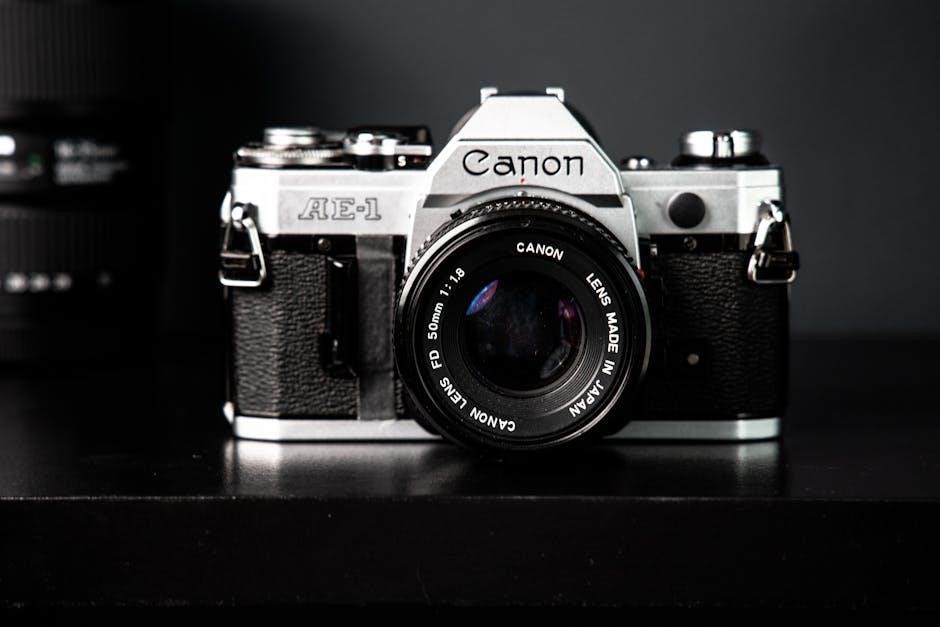
Key Features of the Canon AE-1
The Canon AE-1 features Program AE, Shutter Priority, and Manual modes, offering versatility for photographers. It supports Canon FD lenses, manual focusing, and includes a built-in light meter for precise exposures.
2.1 Lens Compatibility (Canon FD Lenses)
The Canon AE-1 is exclusively compatible with Canon FD lenses, which were specifically designed for this camera series. These lenses feature a unique breech-lock mounting system, ensuring secure and quick lens changes. The FD mount provides full aperture control and supports both automatic and manual focusing. The camera’s metering system works seamlessly with FD lenses to provide accurate exposure readings. Non-FD lenses cannot be used for automatic exposure, requiring manual mode for operation. The FD lens lineup offers a wide range of focal lengths, from wide-angle to telephoto, making the AE-1 highly versatile for various photographic applications. This compatibility ensures optimal performance and image quality, solidifying the AE-1’s reputation as a reliable and adaptable film camera.
2.2 Shutter Speed and Aperture Control
The Canon AE-1 offers precise control over shutter speed and aperture, enabling photographers to achieve desired creative effects. Shutter speeds range from 1/1000th of a second to 1 second, with a Bulb (B) setting for long exposures. Aperture control is managed directly on the lens, allowing for adjustments to suit lighting conditions. In manual mode, both shutter speed and aperture can be set independently, providing full creative control. The camera’s light meter assists in determining optimal exposures, while the Program AE mode automatically selects both settings for ease of use. This dual control system ensures flexibility and simplicity, catering to both experienced photographers and those learning the fundamentals of exposure. The AE-1’s intuitive design makes it easy to balance shutter speed and aperture for stunning results.
2.3 Program AE Mode
The Canon AE-1’s Program AE Mode simplifies photography by automatically setting both aperture and shutter speed for optimal exposures. This mode is ideal for beginners or those seeking convenience, as it eliminates the need for manual adjustments. The camera’s internal logic selects the best combination of aperture and shutter speed based on the lighting conditions, ensuring well-balanced results. Program AE Mode is particularly useful in dynamic shooting situations where time is limited. While it offers ease of use, it still allows for some creative input through exposure compensation. This feature makes the AE-1 versatile, catering to both casual and professional photographers. Its ability to handle complex lighting scenarios effortlessly has made Program AE Mode a standout feature of the camera.

2.4 Manual Mode Capabilities
The Canon AE-1 excels in Manual Mode, offering photographers full control over aperture, shutter speed, and ISO settings. This mode is perfect for those who prefer precise creative control, allowing for tailored exposures to suit individual artistic visions. The camera’s manual capabilities are enhanced by its clear dial-based controls, making adjustments intuitive and efficient. Photographers can manually set aperture using compatible FD lenses and adjust shutter speeds from 1/1000th of a second to 30 seconds, plus a bulb setting for long exposures. The built-in light meter provides accurate exposure readings, aiding in manual adjustments. This level of control makes the AE-1 a favorite among professionals and enthusiasts who value precision and flexibility in their work.

How to Use the Canon AE-1
Load film, set ISO, and use the light meter for precise exposure. Adjust aperture, shutter speed, or mode, then press the shutter to capture your shot effortlessly.
3.1 Loading Film into the Camera
Load film by opening the camera back, inserting the cartridge, and aligning the film with the take-up spool. Advance the film to the first frame using the rapid advance lever. Ensure the film is properly seated and the leader is correctly aligned. Close the back and check the film counter. Always use Canon FD lenses for compatibility. Set the ISO on the lens and camera to match the film speed. If using non-FD lenses, refer to the manual for specific instructions. Loading film correctly ensures proper exposure and functionality of the AE-1’s automatic features. Failure to align the film properly can result in exposure errors or camera malfunction. Always handle film in low-light conditions to prevent overexposure.
3.2 Basic Camera Controls and Functions

The Canon AE-1 features intuitive controls designed for both simplicity and precision. The mode dial allows switching between manual, shutter priority, and program AE modes. The shutter speed dial adjusts exposure time, while the aperture ring on compatible FD lenses controls the lens opening. The ISO setting on the lens mount ensures proper film speed synchronization. The film advance lever is used to load and advance film, while the shutter button triggers exposure. Additional controls include the exposure compensation dial and the stop-down lever for depth-of-field preview. Proper battery maintenance is essential for meter accuracy. Always refer to the manual for detailed operation of these controls. Compatibility with FD lenses ensures optimal performance, and non-FD lenses require specific adjustments as outlined in the manual.
3.3 Setting the ISO
The ISO setting on the Canon AE-1 is located on the lens mount and must be set to match the film speed for accurate exposures. To set the ISO, locate the dial on the lens mount and turn it until it aligns with the film’s ISO number. Ensure the dial clicks into place to confirm the setting. Always check the ISO when loading a new roll of film to avoid incorrect exposures. For non-FD lenses, refer to the manual for specific instructions. Proper ISO setting is crucial for the light meter to function accurately, ensuring optimal results in both manual and automatic modes.
3.4 Using the Light Meter
The Canon AE-1 features a built-in center-weighted light meter that simplifies exposure calculations. To use it, ensure the ISO is set correctly on the lens mount. Look through the viewfinder and align the needle with the desired aperture or shutter speed, depending on the mode. In Program AE, the meter automatically adjusts settings for optimal exposure. In manual mode, adjust aperture or shutter speed until the needle centers. For accurate readings, avoid obstructing the meter or using non-FD lenses without proper setup. Always check the meter in challenging lighting conditions, such as backlit scenes, to ensure balanced exposures. Proper use of the light meter is key to achieving professional-quality photos with the AE-1.
3.5 Shooting in Manual Mode
In manual mode, the Canon AE-1 offers full creative control over exposure settings. To shoot manually, set the ISO on the lens mount and adjust the aperture and shutter speed independently. Use the built-in light meter to guide your settings; align the needle in the viewfinder by adjusting the aperture or shutter speed until the meter is centered. This ensures a balanced exposure. For precise control, use the aperture ring on the lens and the shutter speed dial on the camera body. Manual mode is ideal for experienced photographers who want to fine-tune their shots. Always ensure the battery is functional, as the light meter and shutter require power. With practice, manual mode unlocks the full potential of the AE-1 for custom exposures and artistic expression.
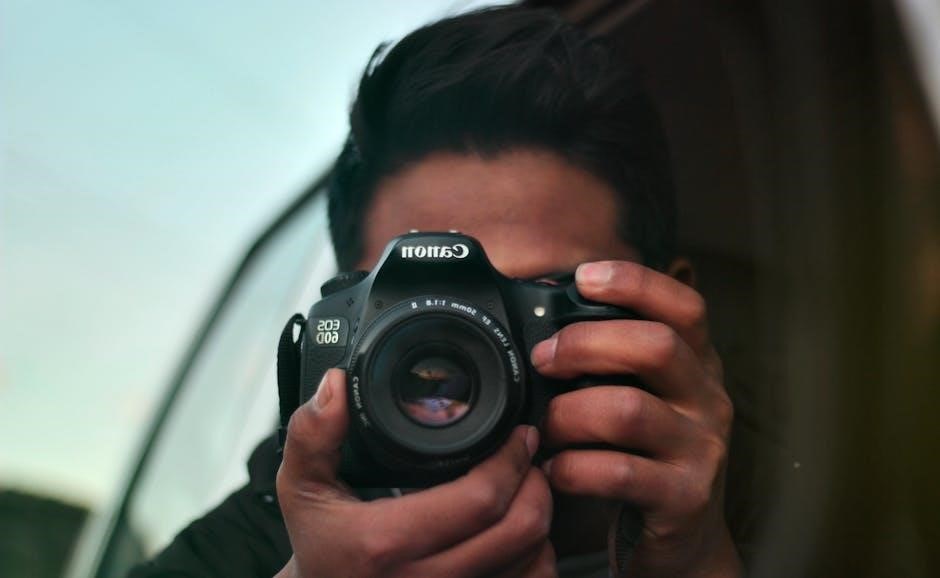
3.6 Shooting in Shutter Priority Mode
Shutter Priority mode allows photographers to set the shutter speed while the camera automatically adjusts the aperture for optimal exposure. This mode is ideal for capturing motion or freezing action. To use Shutter Priority, set the mode dial to “Tv” or “Shutter Priority,” then adjust the shutter speed using the dial on the camera body. The camera will automatically adjust the aperture based on the selected shutter speed and available light. Use the built-in light meter to ensure proper exposure, adjusting the ISO if necessary. This mode is particularly useful for sports, wildlife, or low-light photography. Always ensure the camera has functional batteries, as the light meter and shutter operation depend on them. Shutter Priority mode strikes a balance between creative control and automatic convenience, making it a versatile option for various shooting scenarios. Proper use of this mode requires understanding how shutter speed impacts the image, allowing photographers to achieve desired effects like motion blur or sharp freeze frames. By mastering Shutter Priority, users can enhance their photography skills and explore new creative possibilities with the Canon AE-1.
3.7 Shooting in Program Mode
Program Mode on the Canon AE-1 offers a fully automatic shooting experience, ideal for beginners or quick snapshots. In this mode, the camera automatically selects both the aperture and shutter speed based on the lighting conditions. To use Program Mode, set the mode dial to “Program” and ensure the lens is set to its smallest aperture (highest f-stop number). The camera will then calculate the optimal exposure settings. While the mode is automatic, users can still adjust the ISO to influence the exposure. For added control, the exposure compensation feature can be used to fine-tune the results. Program Mode is perfect for situations where speed and simplicity are prioritized, allowing photographers to focus on composition and subject matter without worrying about manual adjustments. This feature makes the AE-1 highly versatile and user-friendly, catering to photographers of all skill levels. By leveraging Program Mode, users can achieve consistently well-exposed images with minimal effort, making it an excellent choice for everyday photography. The seamless integration of automatic features with manual overrides ensures that the Canon AE-1 remains a practical and creative tool for photographers. Always ensure the camera’s batteries are functional, as they power the light meter and shutter mechanism essential for Program Mode operation. Proper use of this mode enhances the overall photography experience, allowing users to capture high-quality images effortlessly. Whether shooting in dynamic environments or familiar settings, Program Mode provides reliability and convenience, solidifying the AE-1’s reputation as a versatile and enduring camera. This mode is particularly useful for those transitioning from manual to automatic controls, offering the best of both worlds. By mastering Program Mode, photographers can unlock new creative possibilities while enjoying the simplicity of automatic exposure control. The Canon AE-1’s Program Mode is a testament to its innovative design, bridging the gap between technical precision and user-friendly functionality; With its intuitive operation and reliable performance, Program Mode remains a cherished feature among AE-1 enthusiasts and professionals alike. The ability to delegate exposure calculations to the camera frees photographers to focus on artistic elements, ensuring that every shot is both technically sound and creatively compelling. Program Mode exemplifies the Canon AE-1’s commitment to excellence and adaptability, making it a timeless choice for photographers worldwide.
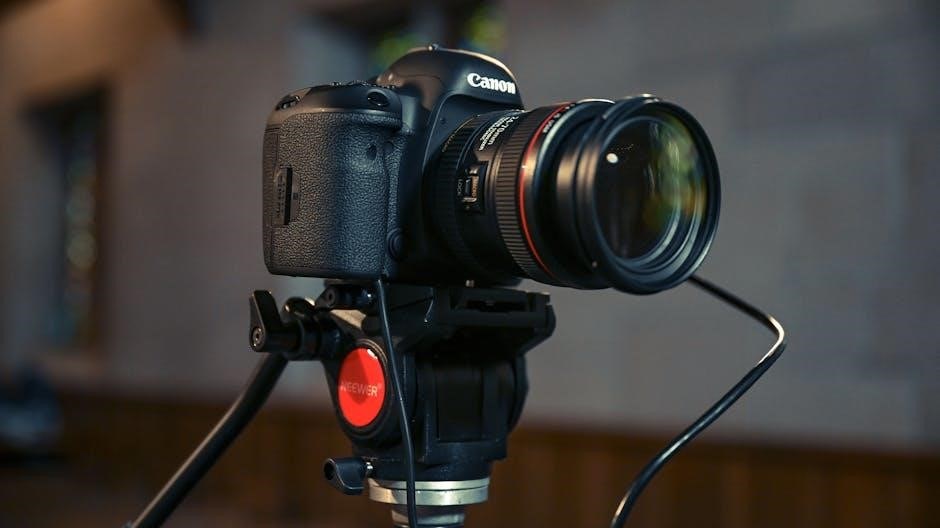
Exposure Control
Exposure control on the Canon AE-1 is managed through aperture, shutter speed, and ISO settings, offering precise adjustments for optimal image quality in various lighting conditions.
4.1 Understanding Aperture
Aperture refers to the opening in the lens that controls the amount of light entering the camera. On the Canon AE-1, aperture settings are denoted by f-numbers, such as f/2.8 or f/16.
A smaller f-number (e.g., f/2.8) means a larger aperture, allowing more light in, while a larger f-number (e.g., f/16) means a smaller aperture, letting less light through.
Aperture also affects depth of field; a larger aperture (smaller f-number) creates a shallower depth of field, blurring the background, while a smaller aperture (larger f-number) keeps more of the image in focus.
Using Canon FD lenses, photographers can manually adjust the aperture to achieve the desired artistic effect, making it a key tool for creative control in film photography.
4.2 Understanding Shutter Speed
Shutter speed determines how long the camera’s shutter remains open, measured in seconds or fractions of a second. On the Canon AE-1, it ranges from 1/1000th of a second to 30 seconds, plus a Bulb (B) setting for extended exposures.
Faster shutter speeds (e.g., 1/1000) freeze motion, ideal for action shots, while slower speeds (e.g., 1 second) create motion blur, adding artistic effects to moving subjects.
The AE-1 allows manual adjustment of shutter speed, enabling photographers to tailor exposures for specific creative outcomes. This feature, combined with aperture control, provides precise command over the image-making process.
Understanding shutter speed is essential for mastering the AE-1, as it directly impacts the look and feel of photographs, from sharp, dynamic captures to ethereal, blurred compositions.
4.3 Understanding ISO Settings
ISO settings on the Canon AE-1 determine the film’s sensitivity to light. Common ISO values range from 25 to 3200, with higher numbers indicating greater sensitivity for low-light conditions.
Selecting the correct ISO is crucial for achieving optimal image quality. Lower ISOs (e.g., ISO 100) are best for bright lighting, minimizing grain and ensuring sharp details.
Higher ISOs (e.g., ISO 400 or 800) are ideal for indoor or low-light photography but may introduce noticeable grain. The AE-1 requires manual ISO setting, giving photographers full control over film sensitivity.
Proper ISO selection balances between image brightness and noise, allowing photographers to adapt to various lighting environments effectively.
4.4 Exposure Compensation
Exposure compensation on the Canon AE-1 allows photographers to adjust the exposure settings beyond the camera’s automatic calculations. This feature is essential for achieving the desired brightness in challenging lighting conditions.
The exposure compensation dial enables adjustments of up to ±2 stops in 1/3-stop increments, providing precise control over the exposure. This feature is particularly useful for capturing high-contrast scenes or when the metered light reading doesn’t match the desired artistic outcome.
By compensating exposure, photographers can ensure that highlights and shadows are preserved, resulting in well-balanced images. This feature complements the camera’s manual controls, offering flexibility and creativity in various shooting scenarios.
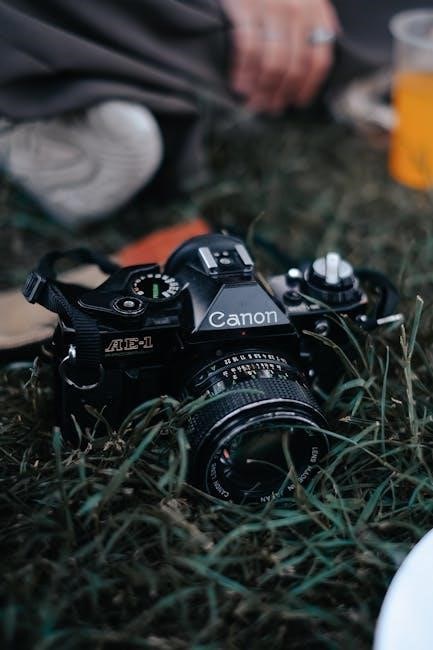
Compatible Lenses and Accessories
The Canon AE-1 is compatible with Canon FD lenses, offering a wide range of focal lengths and aperture options. Accessories include flashes, remote shutters, and lens filters.
5.1 Canon FD Lenses Overview
The Canon FD lens series is specifically designed for the AE-1, offering a wide range of focal lengths and aperture options. These lenses feature a unique breech-mount system, ensuring quick and secure attachment to the camera body. The FD lineup includes prime lenses, zoom lenses, and specialized options like macro and telephoto lenses, catering to various photographic needs. Many FD lenses are known for their high optical quality, durable construction, and smooth aperture control. Notable models include the 50mm f/1.8, 35mm f/2, and 70-200mm f/4 zoom. The FD system’s versatility and compatibility with the AE-1 make it a cornerstone of its functionality and appeal.
5.2 Recommended Lenses for the Canon AE-1
The Canon AE-1 pairs exceptionally well with a variety of FD lenses, each offering distinct capabilities. The 50mm f/1.8 is a popular choice for its compact size and excellent low-light performance. For wide-angle photography, the 35mm f/2 is ideal, offering a broad field of view while maintaining sharpness. The 70-200mm f/4 zoom lens provides versatility for capturing distant subjects, making it perfect for portraits and landscapes. Additionally, the 100mm f/2.8 macro lens is recommended for detailed close-up shots. These lenses, known for their optical clarity and durability, enhance the AE-1’s functionality, allowing photographers to explore diverse creative possibilities with ease and precision.
5.3 Using Non-FD Lenses
While the Canon AE-1 is optimized for FD lenses, using non-FD lenses requires specific adjustments. Manual focusing is necessary, as autofocus is unavailable. Exposure settings must be adjusted manually, using the camera’s aperture priority or manual mode. A stop-down metering method is recommended to ensure accurate exposures. Some non-FD lenses may require modification to fit the AE-1’s mount. Additionally, certain features like shutter priority mode may not function correctly with non-FD lenses. Despite these limitations, photographers can still achieve great results by understanding the camera’s capabilities and adjusting their techniques accordingly. This flexibility allows for experimentation with various lenses, expanding creative possibilities while maintaining the AE-1’s renowned performance.
5.4 Accessories for the Canon AE-1
Enhancing the Canon AE-1 experience, various accessories are available to complement its functionality. Lens hoods and filters protect and enhance image quality, while camera straps improve portability. External flash units, like the Canon Speedlite, offer advanced lighting control. Remote shutter releases minimize camera shake, ideal for low-light shots. Battery grips extend shooting sessions, and lens cleaning kits maintain optical clarity. The AE-1’s compatibility with these accessories ensures versatility for diverse photography needs, making it a robust system for enthusiasts and professionals alike. These additions not only enhance performance but also preserve the camera’s longevity, supporting its enduring popularity in film photography.
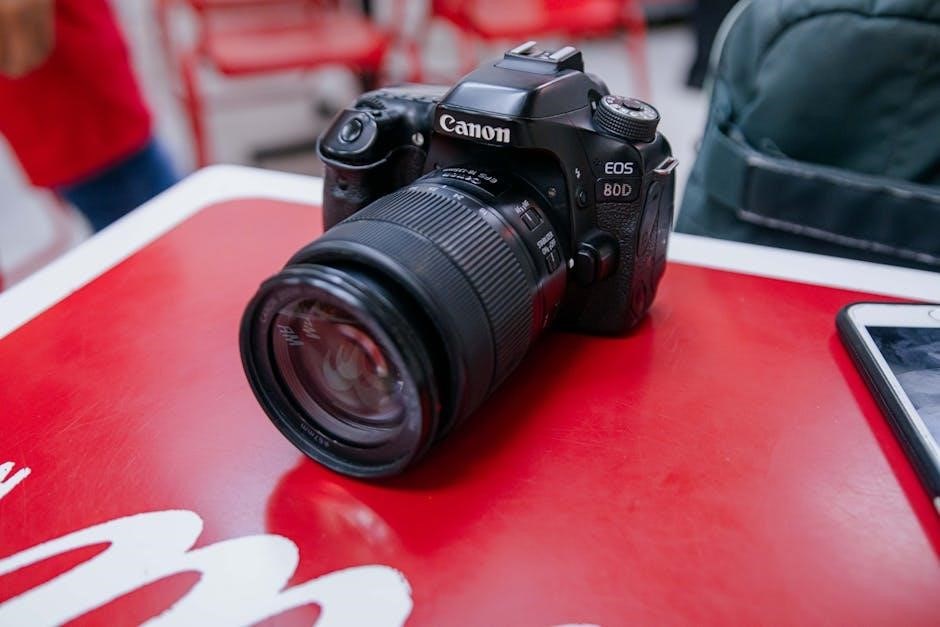
Maintenance and Troubleshooting
Regular cleaning of the camera and lenses ensures optimal performance. Battery maintenance is crucial for reliable operation. Addressing common issues promptly extends the camera’s lifespan and reliability.
6.1 Cleaning the Camera and Lenses
Regular cleaning is essential to maintain the Canon AE-1’s performance. Use a soft, dry cloth to wipe the camera body and external components. For the lenses, employ a microfiber cloth and gentle cleaning solution to remove smudges and fingerprints. Avoid harsh chemicals or abrasive materials that could damage the surfaces. Clean the viewfinder and eyepiece with a soft cloth to ensure clear visibility. For the mirror and interior, use compressed air to remove dust particles. Always handle the camera and lenses with care to prevent scratches or damage. Regular maintenance ensures the camera remains in optimal condition for years of reliable use. Proper cleaning techniques preserve image quality and extend the lifespan of the equipment.
6.2 Battery Maintenance
Proper battery maintenance is crucial for the Canon AE-1’s functionality. Use a 4LR44 or 1CR-1/2N lithium battery to ensure reliable performance. Insert the battery correctly, following the polarity markings. Avoid mixing old and new batteries or using different types simultaneously. If the camera stops working, check the battery compartment for corrosion or improper installation. Clean the terminals with a soft cloth if necessary. Store unused batteries in a cool, dry place away from metal objects to prevent drainage. Replace batteries annually or when the low-battery indicator appears. Always handle batteries carefully to avoid leakage or damage. Proper care extends the camera’s operational life and ensures consistent performance during photography sessions.
6.3 Common Issues and Solutions
The Canon AE-1 may experience issues like jammed shutters or inaccurate light meter readings. Clean the shutter curtains with a soft brush and ensure proper film loading. For light meter inaccuracies, check battery levels or clean the meter sensors with a dry cloth. If the camera fails to fire, inspect the battery compartment latch, which may need adjustment with a small screwdriver. Sticky aperture blades can be cleaned with a cotton swab and isopropyl alcohol. Avoid using harsh chemicals or excessive force. Regular maintenance and proper storage can prevent many of these issues. Always refer to the manual for troubleshooting guidance to ensure the camera operates at its best.

The Legacy of the Canon AE-1
The Canon AE-1 remains a beloved icon in film photography, cherished for its reliability, intuitive design, and enduring influence on both professionals and enthusiasts worldwide.
7.1 Impact on Film Photography
The Canon AE-1 significantly influenced film photography by democratizing advanced features, making them accessible to hobbyists and professionals alike. Its introduction in 1976 marked a shift towards user-friendly designs, blending manual controls with program modes. This versatility allowed photographers to explore creative possibilities while maintaining precision. The AE-1’s reliability and affordability contributed to its widespread adoption, fostering a culture of experimentation and artistic expression. It became a staple in photography education, teaching generations about aperture, shutter speed, and ISO. The AE-1’s enduring popularity underscores its role in preserving the art of film photography, even in the digital age, as enthusiasts continue to value its tactile experience and timeless results.
7.2 Popularity Among Collectors
The Canon AE-1 has become a highly sought-after camera among collectors due to its timeless design, reliability, and historical significance. Its durable construction and iconic styling make it a prized possession for photography enthusiasts. Collectors appreciate its versatility, as it appeals to both experienced photographers and those nostalgic for film photography. The AE-1’s compatibility with Canon FD lenses and its manual controls further enhance its appeal. Many collectors also value its accessibility, as it remains affordable compared to other vintage cameras. Its enduring popularity is a testament to its status as a landmark device in photography history, blending innovation with a classic aesthetic that continues to captivate film photography enthusiasts worldwide.
7.3 Comparison with Other Classic Cameras
The Canon AE-1 stands alongside iconic cameras like the Nikon FM2 and Pentax K1000, yet its blend of manual and automatic features sets it apart. While the Nikon FM2 excels in durability and precision, the AE-1’s program mode offers unparalleled ease of use. The Pentax K1000, known for its simplicity, lacks the AE-1’s advanced metering and automation. Collectors often favor the AE-1 for its balance of innovation and accessibility. Its compatibility with Canon FD lenses and robust build quality make it a preferred choice over competitors. The AE-1’s enduring popularity lies in its versatility, appealing to both professionals and hobbyists. Its influence on film photography is undeniable, solidifying its place among the greatest cameras ever made.
The Canon AE-1’s enduring legacy as a iconic film camera lies in its blend of innovation, accessibility, and timeless design, making it a cherished tool for photographers and collectors alike.
8.1 Final Thoughts on the Canon AE-1
The Canon AE-1 is a testament to innovative design and enduring functionality, offering photographers a perfect balance of manual control and ease of use. Its compatibility with FD lenses ensures versatility, while its program AE mode caters to both professionals and newcomers. The camera’s robust build and intuitive controls have solidified its place as a favorite among collectors and enthusiasts. With proper maintenance, the AE-1 continues to deliver exceptional results, making it a timeless companion for those passionate about film photography. Its impact on the medium is undeniable, proving that even decades later, the AE-1 remains a remarkable tool for capturing life’s moments.
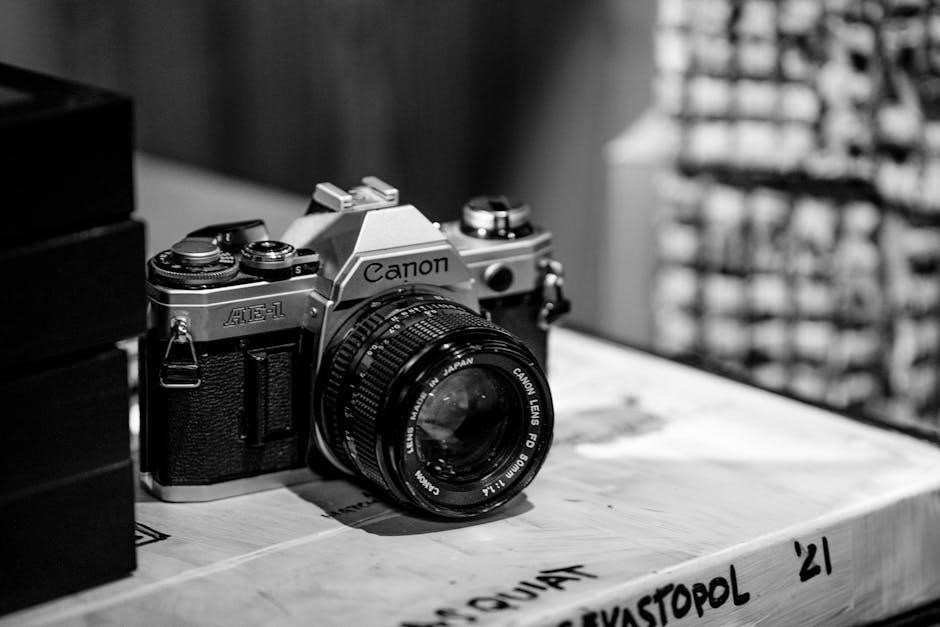
No Responses